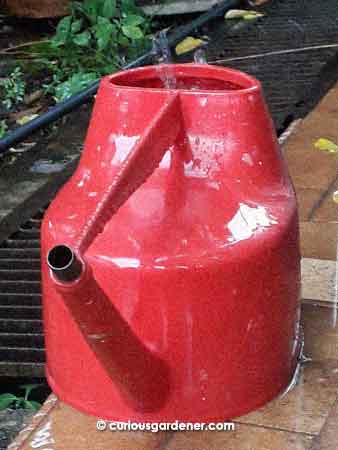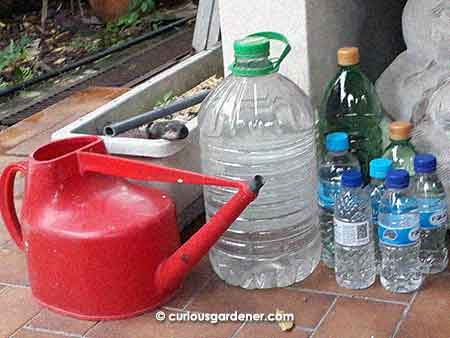Water is so crucial to life. In survival situations, we can live without food for more than three weeks but only for about three days without water. Plants, too, need plenty of water, and in learning about permaculture and how to establish a homestead, a source of water is the first thing one needs to attend to – for people, plants and any animals you may have.
Okay, so we don’t have a rural situation here in Singapore, and we’ve got an easy supply of water and utilities available. However, it comes at a literal cost. A rising cost, too, where water is concerned. I know that I cringe a little when I have to water our plants on hot days – when the watering can fills with water from the tap, I almost hear the tinkling of coins… It’s also been quite a while since I stopped watering plants out in the garden unless they’re young and need the help. If they can’t survive in our climate, I choose not to grow them. It’s only our nursery and potted plants that get the TLC.
So why don’t we collect rainwater? It’s free, isn’t it? Well, I recall some time ago that it was not legal to do so here. OMG, some people will exclaim, everything is so controlled in this country! Well, yes, but there’s a reason why this was so. It’s a small country with limited water resources, and an increasing population. The drainage system was designed to collect rainwater and channel it to the reservoirs. At some point more than ten years ago – I think it was 2004 – the rule about rainwater collection was finally changed. I think that was when the goal of using two-thirds of the country’s landmass as water catchment was reached. So, yes, we can now collect rainwater to water our plants with! It is only for non-potable use, though, meaning it shouldn’t be used for drinking, cooking and bathing.
Before you start getting any grand ideas for irrigating your garden, though, you’d better check what’s allowed. Yes, of course there are rules and regulations! Some people complain that too many things are micromanaged, but I believe there are good reasons for these. Not everybody has the good sense to know how to manage what we may think are basic issues. What’s so difficult about harvesting water? Well, the biggest concern to me is the pesky mosquito. If you’re not careful, mozzies will start breeding in your stored water. This happened in our neighbourhood more than fifteen years ago and there was an outbreak of dengue fever, which I was unfortunate to get. So, I’m all for people getting educated about the correct way to do things.
If you intend to plumb collected rainwater into your house, it’s best you employ professionals to do the work as they will know what’s required by law. This would include doing both the piping as well as knowing the best ways to prevent mosquito breeding. Besides watering your plants, this water could be used for general washing and flushing toilets, too.
So let’s think about how you’re going to harvest the rainwater. I tried simply placing a container below the edge of the roof where water drips down when it rains, and that worked very well. I guess if you’re more ambitious and want to collect more water, you’ll need to look into doing some piping that leads into a storage tank. That, of course, needs to be mosquito-proofed, meaning that there should be no gaps anywhere, it should be covered with rust-proof fine mesh, and sealed shut when not in use. NEA recommends that the water should not be stored, unused, for more than seven days as this is enough time for mosquito larvae to reach adulthood. To play it safe, you can also use larvicides that are not toxic to people and animals in your stored harvested rainwater.
For my current simple needs, I used a 5-litre watering can to collect rainwater from roof edge drip, then transferred the water into recycled plastic bottles with screw tops for storage. It took less than ten minutes during steady rainfall to fill the watering can, which I repeated until I ran out of bottles. Now I need to store the bottles away from direct sunlight so that algae doesn’t grow in them. They hold over a week’s worth of water for our potted plants. This may be the start of something bigger, because I wish I’d saved more bottles, or had more of the large bottles!
If you want to find out more, visit the Public Utilities Board and National Environment Agency websites.
© 2017 curiousgardener.com All rights reserved.


